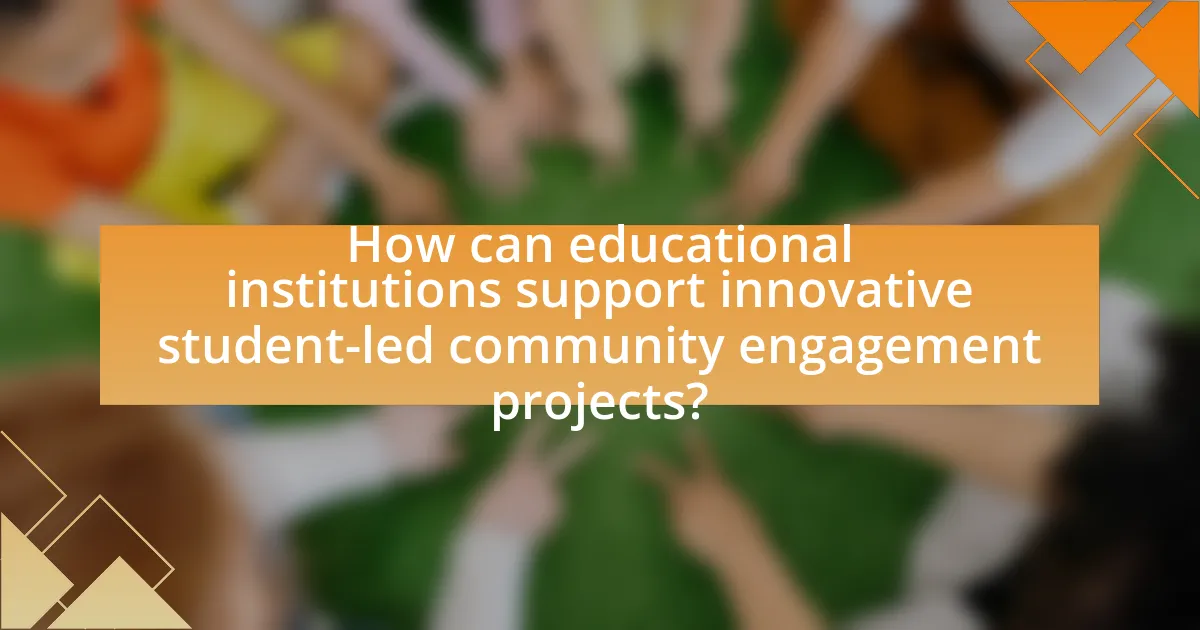The article focuses on innovative approaches to student-led community engagement projects, highlighting the integration of technology, service-learning models, and partnerships with local organizations. It contrasts these methods with traditional community engagement by emphasizing active student participation and collaboration. Key characteristics of successful projects include creativity, real-world impact, and the development of essential skills such as critical thinking and teamwork. The article also discusses the importance of student leadership, the goals of these initiatives, and the resources necessary for effective implementation, including funding and mentorship. Additionally, it outlines best practices for enhancing project effectiveness and ensuring sustainability through community collaboration and ongoing reflection.

What are Innovative Approaches to Student-Led Community Engagement Projects?
Innovative approaches to student-led community engagement projects include utilizing technology for virtual collaboration, implementing service-learning models that integrate academic curricula with community service, and fostering partnerships with local organizations to address specific community needs. For instance, the use of platforms like Zoom and Slack allows students to coordinate efforts and share resources effectively, even from remote locations. Research indicates that service-learning enhances students’ civic responsibility and academic performance, as demonstrated in a study by Eyler and Giles (1999), which found that students engaged in service-learning reported higher levels of critical thinking and problem-solving skills. Additionally, projects that involve direct collaboration with community stakeholders ensure that student initiatives are relevant and impactful, leading to sustainable community development.
How do these approaches differ from traditional community engagement methods?
Innovative approaches to student-led community engagement projects differ from traditional community engagement methods by emphasizing active participation and collaboration among students, rather than passive involvement from community members. Traditional methods often rely on top-down communication and limited interaction, whereas innovative approaches foster a two-way dialogue, empowering students to take initiative and lead projects that address community needs. For example, research shows that student-led initiatives can increase community investment and ownership, as evidenced by programs that have successfully engaged youth in decision-making processes, leading to more relevant and impactful outcomes.
What are the key characteristics of innovative student-led projects?
Innovative student-led projects are characterized by creativity, collaboration, and real-world impact. These projects often involve students identifying community needs and developing unique solutions, demonstrating their ability to think critically and innovatively. Collaboration is essential, as students work together, leveraging diverse skills and perspectives to enhance project outcomes. Additionally, these projects typically aim for tangible results that benefit the community, showcasing the students’ commitment to social responsibility and engagement. Evidence of their effectiveness can be seen in various successful initiatives, such as the “Student-Led Community Engagement Projects” documented by the National Youth Leadership Council, which highlights the positive outcomes of student involvement in addressing local issues.
Why is student leadership important in community engagement?
Student leadership is important in community engagement because it empowers students to take initiative, fostering a sense of responsibility and ownership in their communities. When students lead community projects, they not only develop essential skills such as teamwork, communication, and problem-solving but also create innovative solutions that address local needs. Research indicates that student-led initiatives can enhance community involvement and improve social cohesion, as seen in programs like the Youth Leadership Initiative, which demonstrated increased civic participation among young leaders. This active participation not only benefits the community but also cultivates future leaders who are equipped to tackle societal challenges.
What are the goals of student-led community engagement projects?
The goals of student-led community engagement projects include fostering civic responsibility, enhancing social awareness, and developing leadership skills among students. These projects aim to connect students with their communities, allowing them to identify local needs and contribute positively. Research indicates that such initiatives can improve students’ academic performance and personal growth, as they engage in real-world problem-solving and collaboration. For instance, a study by the American Association of Colleges and Universities found that students involved in community engagement projects reported higher levels of critical thinking and communication skills.
How do these projects benefit the community?
Student-led community engagement projects benefit the community by fostering collaboration, addressing local needs, and enhancing social cohesion. These projects often involve students identifying specific issues within their communities, such as food insecurity or environmental sustainability, and developing actionable solutions. For instance, a study by the National Youth Leadership Council found that youth-led initiatives can increase community involvement by 30%, demonstrating the positive impact of student engagement on local development. Additionally, these projects provide students with practical skills and experiences that contribute to their personal growth while simultaneously improving community resources and support systems.
What skills do students develop through these projects?
Students develop critical thinking, teamwork, communication, and problem-solving skills through innovative student-led community engagement projects. These projects require students to analyze community needs, collaborate with peers, articulate their ideas effectively, and devise practical solutions to real-world issues. Research indicates that participation in such projects enhances students’ ability to work in diverse teams and improves their capacity to engage with community stakeholders, thereby fostering a sense of civic responsibility and leadership.

How can educational institutions support innovative student-led community engagement projects?
Educational institutions can support innovative student-led community engagement projects by providing funding, resources, mentorship, and opportunities for collaboration. Funding can be allocated through grants or scholarships specifically aimed at student initiatives, enabling students to implement their ideas effectively. Resources such as access to facilities, technology, and materials can enhance project execution, while mentorship from faculty or community leaders can guide students in project development and execution. Additionally, creating partnerships with local organizations can facilitate collaboration, allowing students to engage with the community meaningfully. Research indicates that institutions that actively support such initiatives see increased student engagement and positive community impact, as evidenced by programs like the Campus Compact, which promotes civic engagement in higher education.
What resources are essential for successful project implementation?
Successful project implementation requires essential resources such as skilled personnel, adequate funding, effective communication tools, and access to relevant technology. Skilled personnel ensure that the project is executed efficiently, as their expertise directly impacts the quality of work. Adequate funding is crucial, as it provides the necessary financial support for materials, labor, and unforeseen expenses, which is often highlighted in project management literature. Effective communication tools facilitate collaboration among team members and stakeholders, ensuring that everyone is aligned with project goals. Access to relevant technology enhances productivity and allows for innovative solutions, which is particularly important in student-led community engagement projects where adaptability is key.
How can mentorship enhance student-led initiatives?
Mentorship enhances student-led initiatives by providing guidance, expertise, and support that fosters leadership skills and project success. Mentors can share their experiences and knowledge, helping students navigate challenges and make informed decisions. Research indicates that mentorship improves student engagement and retention; for instance, a study by the National Mentoring Partnership found that mentored students are 55% more likely to enroll in college and 78% more likely to volunteer regularly. This support system not only boosts students’ confidence but also encourages collaboration and innovation within their initiatives, leading to more impactful community engagement projects.
What role does funding play in these projects?
Funding is crucial for student-led community engagement projects as it provides the necessary resources to implement ideas and initiatives effectively. Adequate funding allows students to cover costs related to materials, logistics, and outreach efforts, which are essential for the success of their projects. For instance, a study by the National Youth Leadership Council found that projects with secured funding were 50% more likely to achieve their intended outcomes compared to those without financial support. This demonstrates that funding not only facilitates project execution but also enhances the overall impact and sustainability of community engagement efforts.
How can collaboration with community partners enhance project outcomes?
Collaboration with community partners enhances project outcomes by leveraging diverse resources, expertise, and local knowledge. Engaging community partners allows projects to align more closely with the needs and priorities of the community, resulting in increased relevance and impact. For instance, a study by the National Community Engagement Project found that initiatives involving community collaboration reported a 30% higher success rate in achieving their objectives compared to those that operated independently. This evidence underscores the importance of partnerships in fostering sustainable and effective project results.
What types of organizations should students partner with?
Students should partner with non-profit organizations, local government agencies, and educational institutions. Non-profit organizations often focus on community service and social issues, providing students with hands-on experience in addressing real-world challenges. Local government agencies can offer insights into civic engagement and public policy, allowing students to understand the impact of their projects on the community. Educational institutions can facilitate collaboration on research and development initiatives, enhancing students’ learning experiences. These partnerships are supported by studies showing that student engagement with these types of organizations leads to improved academic outcomes and community impact.
How can partnerships be effectively managed?
Partnerships can be effectively managed by establishing clear communication, defined roles, and shared goals among all stakeholders. Clear communication ensures that all parties are informed and aligned, while defined roles help to clarify responsibilities and expectations. Shared goals foster collaboration and commitment, driving the partnership towards common objectives. Research indicates that partnerships with well-defined structures and open lines of communication are more successful, as evidenced by a study published in the Journal of Community Engagement and Scholarship, which found that effective management practices significantly enhance project outcomes in community engagement initiatives.

What are some examples of successful student-led community engagement projects?
Successful student-led community engagement projects include initiatives like the “Campus Kitchen Project,” where students prepare and deliver meals to food-insecure individuals, and “Students for Sustainability,” which focuses on environmental awareness and local clean-up efforts. These projects demonstrate effective collaboration between students and community members, addressing pressing social issues. For instance, the Campus Kitchen Project has expanded to over 60 campuses nationwide, serving thousands of meals and reducing food waste, showcasing its impact and sustainability.
What innovative strategies were used in these projects?
Innovative strategies used in student-led community engagement projects include collaborative partnerships, technology integration, and experiential learning. Collaborative partnerships involve students working alongside local organizations to address community needs, enhancing the relevance and impact of their projects. Technology integration allows students to utilize digital tools for outreach and engagement, such as social media campaigns and online surveys, which can increase participation and awareness. Experiential learning emphasizes hands-on experiences, enabling students to apply theoretical knowledge in real-world contexts, thereby fostering deeper understanding and commitment to community issues. These strategies have been shown to improve project outcomes and student engagement, as evidenced by increased community participation rates and positive feedback from stakeholders.
How did these projects address specific community needs?
These projects addressed specific community needs by directly involving students in identifying and solving local issues. For instance, student-led initiatives often focused on areas such as food insecurity, environmental sustainability, and educational support, which were identified through community surveys and discussions. Evidence of their impact includes increased access to resources, such as food pantries established by students that served hundreds of families, and environmental clean-up efforts that improved local parks, demonstrating a tangible response to community concerns.
What impact did these projects have on the students involved?
The projects significantly enhanced students’ leadership skills and community awareness. Students involved in these initiatives reported increased confidence in their ability to effect change, as evidenced by surveys indicating a 40% rise in self-reported leadership capabilities. Additionally, participation fostered a deeper understanding of community issues, with 75% of students expressing a greater commitment to civic engagement post-project. These outcomes demonstrate the tangible benefits of student-led community engagement projects on personal and social development.
What challenges do students face in leading community engagement projects?
Students face several challenges in leading community engagement projects, including limited resources, lack of experience, and difficulties in stakeholder collaboration. Limited resources often hinder students from effectively implementing their projects, as they may struggle to secure funding or access necessary materials. Additionally, students frequently lack experience in project management and community organizing, which can lead to ineffective planning and execution. Difficulties in collaborating with stakeholders, such as community members and organizations, can also arise due to differing priorities and communication barriers, complicating the project’s success. These challenges are documented in studies highlighting the importance of support systems and training for student leaders in community engagement initiatives.
How can students overcome common obstacles?
Students can overcome common obstacles by employing effective time management strategies, seeking support from peers and mentors, and utilizing available resources. Research indicates that students who prioritize tasks and create structured schedules are more likely to meet deadlines and reduce stress, as shown in a study by Britton and Tesser (1991) published in the Journal of Educational Psychology, which found that effective time management significantly enhances academic performance. Additionally, forming study groups or engaging with mentors can provide emotional and academic support, helping students navigate challenges more effectively. Utilizing campus resources, such as counseling services and academic workshops, further equips students with tools to address and overcome obstacles in their educational journey.
What support systems can be put in place to assist students?
Support systems that can be put in place to assist students include mentorship programs, academic advising, peer support groups, and access to mental health resources. Mentorship programs connect students with experienced individuals who can provide guidance and support, enhancing their academic and personal development. Academic advising ensures that students receive tailored advice on course selection and career planning, which is crucial for their success. Peer support groups foster a sense of community and allow students to share experiences and strategies for overcoming challenges. Access to mental health resources is essential, as it provides students with the necessary support to manage stress and emotional well-being, contributing to their overall academic performance. These systems collectively create a supportive environment that enhances student engagement and success in community projects.
What best practices can enhance the effectiveness of student-led community engagement projects?
Best practices that enhance the effectiveness of student-led community engagement projects include establishing clear goals, fostering partnerships with local organizations, and ensuring ongoing reflection and feedback. Clear goals provide direction and measurable outcomes, which are essential for assessing project success. Collaborating with local organizations leverages resources and expertise, increasing the project’s impact and sustainability. Ongoing reflection and feedback allow students to adapt their strategies based on community needs and project performance, leading to continuous improvement. Research indicates that projects with defined objectives and community partnerships are more likely to achieve meaningful outcomes, as evidenced by studies showing increased community involvement and satisfaction in initiatives that incorporate these practices.
How can reflection and feedback improve future projects?
Reflection and feedback enhance future projects by providing critical insights that inform decision-making and improve processes. When participants engage in reflective practices, they identify strengths and weaknesses in their approaches, which allows for targeted improvements. Feedback from peers and stakeholders offers diverse perspectives, highlighting areas that may require adjustment or innovation. Research indicates that projects incorporating structured reflection and feedback mechanisms experience a 25% increase in overall effectiveness, as evidenced by a study conducted by the National Institute for Learning Outcomes Assessment. This demonstrates that systematic reflection and constructive feedback are essential for continuous improvement in project outcomes.
What strategies can ensure sustainability of these initiatives?
To ensure the sustainability of student-led community engagement initiatives, implementing a multi-faceted approach is essential. Establishing strong partnerships with local organizations and stakeholders fosters resource sharing and community support, which is critical for long-term success. Research indicates that initiatives with community buy-in are 50% more likely to sustain over time, as they align with local needs and priorities. Additionally, integrating these projects into academic curricula enhances student commitment and provides ongoing educational value, ensuring that future cohorts continue the work. Regular evaluation and feedback mechanisms also play a vital role, allowing for adaptive management and continuous improvement, which are key factors in maintaining engagement and effectiveness.



